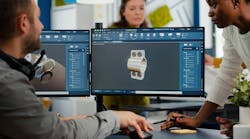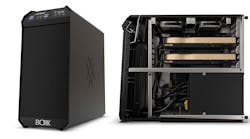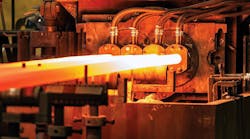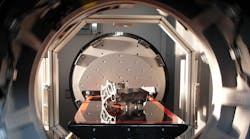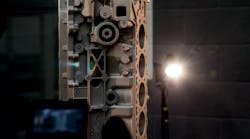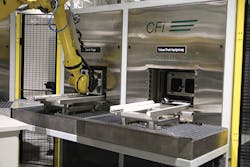The automotive industry is working to prolong its recent growth and redirect its future, a multi-directional strategy that requires vehicle manufacturers to continue revamping and retooling for current needs, simultaneously pushing capital and resources toward visionary ideas for future models, technologies, and production processes.
Ford Motor Co. has outlined capital investments totaling $1.2 billion for two assembly plants and an engine plant in Michigan — projects that signal continued confidence in the pickup truck and SUV category; and an increasing level of commitment to the phenomena of self-driving and connected vehicles, hoping to define that new level of technology before new (and current) competitors gain the advantage.
General Motors is charting a similar course, making capital investments at three Michigan plants as it shifts production toward SUVs and crossovers, and ventures forth with various developments in hybrid and electric vehicle technologies. And, this pattern of revamping for the present and whiteboarding for the future is evident among the other major automakers too.
For the manufacturers that supply automakers — specifically for foundries and diecasters — these are not trends. They reflect the recent past and the current status for metalcasters, investing in new capacity and new technologies in order to secure a position in the automotive OEMs’ supply chains, and adopting new design and manufacturing methods in order to enhance the level of quality control and service that automotive manufacturers require.
Consider first the metalcasters’ investments in new capacity: Mexico has been the site of multiple automotive casting developments, with plants completed and under construction, and existing operations expanding capacity and adding new capabilities. Last month Nemak inaugurated its 36th plant and its seventh in Mexico, with high-pressure diecasting for aluminum engine blocks, transmission cases and structural parts. Nemak has reported the total investment in the new operation (which will include finish-machining capabilities) at $200 million.
Metalcasting expansion has not been limited to Mexico, of course: The southeastern U.S. has seen a boon in new foundry capacity, and there are projects emerging in central Europe seeking to maximize the regional automotive demand.
Moreover, the new-capacity trend is not limited to any particular material or style of metalcasting. The recent developments have expanded ferrous and nonferrous casting of all sorts — HPDC, diecasting, investment casting, and sand casting operations.
Of course, installing new metalcasting capacity can be a slow process, and in some instances supplying the automotive sector cost-effectively calls for capacity consolidation, as seen in American Axle & Manufacturing’s $1.6-billion acquisition of Metaldyne Performance Group (and its Grede Foundries operations) — a deal that reignites hope of those who foresee metalcasting as just one facet of a diversified forming portfolio.
Metalcasters also are expanding the scope of their services to their automaking customers, notably in the services they are providing to raise the value of the parts they deliver. Finish machining, heat-treating, and even assembly are increasingly standard for automotive foundries.
Product, Process Development
The necessity of impregnation technologies to seal cast parts’ surface conditions is direct result of automakers’ changing expectations. Recently Godfrey & Wing installed its automated Continuous Flow Vacuum Impregnation System (CFi) for Schabmüller Automobiltechnik GmbH, which supplies mechanical engineering, machining, and system assembly services to automotive OEMs and Tier 1 suppliers. The plant in Ingolstadt, Germany, will use the system to impregnate cylinder head covers for Audi’s V6 engines.
Audi requires the cast aluminum cylinder heads it purchases to undergo 100% porosity, so by integrating the CFi with in-house production Schabmüller is able to meet the production cost, volume, and quality specifications of the buyer.
This new CFi system includes the most advanced porosity sealing technology available with the capability of sealing 600,000 units per year, according to Godfrey & Wing. The CFI’s modular design allows Schabmüller to integrate vacuum impregnation directly into the head cover manufacturing line. Robotic automation provides repeatable processing with minimal maintenance, and eliminates part contamination and handling damage.
An alternative Godfrey & Wing system — the High Value/Low Volume (HVLV) semi-automated, modular operation that uses a dry vacuum and pressure processing — recently was ordered by Mahle GmbH, to seal diecast aluminum air-conditioning compressor parts at its Juarez, Mexico plant. Five HVLV systems will be installed there this year.
G&W also is helping foundries detect casting porosity via X-ray inspection. It introduced an inspection system in Toledo, OH, recently, complementing an X-ray system nearby in Defiance, OH, so foundries (and OEMs) have the option of continuous, high-volume inspection or individual diagnostics. Trained X-ray technicians inspect parts, and provide images and data documenting the size and location of any defects, addressing the potential risks, hidden costs, and production delays of scrapped castings caused by porosity.
Some technologies that would have been labeled “advanced” just a few years back are becoming standard now for the most successful automotive foundries. That certainly describes Grainger & Worrall (GW), one of the world’s foremost developers of automotive engine products, with sand casting capability for specialty iron and aluminum alloys.
With particular skill at developing powertrain and structural castings for high-performance and motorsports clients, Grainger is far along in the process of designing lighter and smaller automotive parts. Its work, naturally, takes every available advantage, starting from the product design stage.
“We can now virtually engineer and design using CAD,” according to Keith Denholm, engineering and technology director at Grainger & Worrall. “We can produce tooling and sand cores direct from digital data sets.
He continued: “We can make castings in the classical way, but we can then take those parts and put them through very capable technologies such as CT (computed tomography), optical scanning, and laser scanning. We have all those technologies, which enable us to do the verification and certification processes very quickly.”
CAD invariably leads designers and foundries to the development of new designs for products now in high demand. Recently Grainger & Worrall worked with Jaguar Land Rover and Britain’s Advanced Propulsion Centre (APC) to develop a new cylinder block, including a plasma coating step to aid in weight and size reduction.
Downsizing and light-weighting are two challenges being addressed by GW as part of consortium of U.K. automotive suppliers, each with different disciplines sharing expertise and knowledge.
The GW development is a process for reliably spraying a low-friction plasma coating on an all-aluminum cylinder block. This innovation removes the need for cylinder liners, because the plasma coating is applied directly to the cylinder bores.
Edward Grainger, managing director for prototyping at GW, said: “We have worked closely as part of the ALIVE6 team to develop a casting process and associated supply chain to support this leading-edge technology. Developing and manufacturing a cylinder block casting suitable for the plasma technology has required us to fundamentally re-assess the metallurgical properties of castings. This has involved us exploring elements such the structural strength of the cylinders as well as the porosity and adhesive properties of the alloys to deliver a successful project outcome.”
Grainger added that “The plasma coating process fits perfectly with our vertically integrated manufacturing capability, which comprises CAD design, casting, machining, plasma coating, honing and final assembly.”
A successful development, by any source or supplier, will be copied or adopted by other automakers, so a breakthrough for Jaguar Land Rover will not be exclusive for long. It’s a small detail that demonstrates how quickly the future arrives for automaking manufacturing – and proving that the work being done by automotive foundries now are keeping them ahead of the trends and perfectly in step with their customers.


